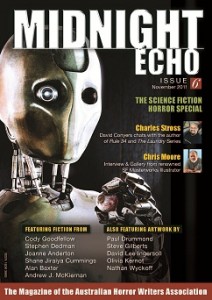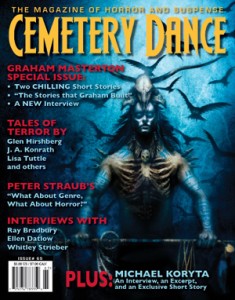 Terra Magazine, Issue #1
Terra Magazine, Issue #1
Edited by Jason Franks
ISBN: 9781921872167
Publisher: Black House Comics
Terra Magazine, from Sydney-based Black House Comics, is a throw-back. A return to comics of a different era. Without political or social agenda, they were made to entertain; to shock and to thrill and to make you laugh. In many ways, Terra Magazine reminds me of that. Of EC Comics and early 2000AD.
In Terra Magazine‘s first issue, editor Jason Franks has assembled a varied collection of artists and writers. And an even more varied collection of genres. The almost Frazetta-like cover by Jason Paulos, the first thing that will catch your eye on the news-stands, is a brilliant evocation not only of the first story (see below), but also of the pulpish nature of the entire comic/magazine.
From the opening “Gourmand Go in ‘Memorial Soup’“, written by Franks with artwork by Harry Purnell, we are thrust immediately into deep space. This is exactly the sort of tale I remember reading in old 2000ADs; a ship crewed with human mercenaries, stuck drifting due to a busted Fission Drive, their distress signal picked up by the biggest, ugliest, meanest looking cockroach-lobster aliens in the galaxy. But you just know there is going to be a twist. While not exactly unpredictable, the story is fun. The writing is clear and concise and the artwork crisp and quirky.
Next up, we’re off to feudal Japan for “Kensuke“. Written again by Franks, but with artwork by Tom Bonin, this story couldn’t be more different than the opener. What struck me most was the total change, not only of genre, but of the feel of the artwork. While Purnell’s art for “Gourmand Go…” consisted of crisp line-work and lettering, Bonin’s approach in “Kensuke” is much rougher, sketchier, offering up a style more in line with the setting. And the story? Samurai warriors. Martial arts monks. Court intrigue. Concubines. Ninjas. Need I say more?
It is these shifts in genre and style that make Terra Magazine so much fun. The very next story, “The Catamorph“, with a script by Chris Sequeira and art by Jan Scherpenhuizen, places us firmly back in EC Comics ‘Tales from the Crypt‘ territory. Two cops respond to a break and enter alarm from the posh-end of town only to encounter a — quite animated — Ancient Egyptian mummy, and so much more besides. The script and artwork are sort of timeless in this supernatural-noir tale. It could be the 60s, or the 70s, or any decade onwards. I tend to favour a late 80s setting – wait until you see the push button phone in the Police Office! Apart from these initial panels though, there isn’t much in the way of visual clues to tell us exactly ‘when’ we are… and I see this as a good thing leading forward for “The Catamorph“. As I said: timeless.
“Shadowmancy: Episode 1, The Key in the Wall“, with a script by Jason Franks and art by Nicholas Hunter, continues on in a similar mode. The artwork is more modern, with sharp Manga-inspired lines, but the story is still straight out of something I would have read as a kid in the 70s and 80s. For me, a new and refreshing take on that nostalgia seems to be what Terra Magazine is all about. In “Shadowmancy…“, young Quay decides the follow his mysterious and often absent father, only to find himself the centre of a battle between powerful sorcerers at a secret academy. The panels in this segment are really well composed. The script is sparse and increasingly intriguing. Once begun, I just had to keep going through to the end … and this is where I was reminded of what might be Terra Magazine‘s single downfall.
The story sequences are just too darn short!
Of those reviewed so far, only “Gourmand Go…” has anything resembling a self-contained story. I’m hoping for more stories set on that deep space kitchen, but if not, that’s okay. Everything else, though? Yep! To Be Continued…
It might not be so bad if the stories weren’t all so good. So much fun. Maybe then, I wouldn’t have to worry about the wait between issues. But, tri-annual? I have to wait one third of a year before I get to see if Imperial Guard Kenuke gets away? Or whether detectives Vic and Doyle get any closer to discovering the Mummy’s secret? That’s quite a torturous wait for a reader, especially when the story crumbs are so small (but oh so tasty). “Shadowmancy...” was, to me, the most interesting story in terms of future development, but just for one more page, or another two pages, or three! I definitely feel it could have given more.
“Gun Smoke Bud“, with a script by Jason Franks and art by Yuriko Sekine, is in a style I’m not overly familiar with. I’m guessing it’s manga inspired. The story is simple enough — Two Tokyo detectives investigate a Yakuza massacre at a shopping mall, their only witness? A young stoner — but it doesn’t give us much indication of where it might be heading in the future. And after the crisply stylised lines of “Shadowmancy“, the artwork didn’t do that much for me.
The final panelled story is Ben Michael Byrne’s “Prototype“. Written and illustrated by Byrne, “Protoype” is another short, self-contained, 2000AD style sci-fi story. Nothing serious, just good fun with the usual gruesome twist at the end. The darker, blockier artwork really suits the piece and it is quite different from anything else in the magazine. I can see this continuing with a new short, and comically-nasty, story each issue.
Which brings us to the final story, “Tusk” by Jason Fischer, which isn’t a comic at all. Still in keeping with the serialised nature of the magazine, “Tusk” plumbs the Golden Age of genre fiction with something that could have come right out of an early 70s issue of Analog. “Tusk” is straight prose — with a few Rhys James illustrations sprinkled throughout — of the sort that Mr Fischer has become well known for: tight, well written, original and more than a little bit gonzo. “Tusk” is The Planet of the Pachyderms with a healthy dash of Robert E Howard thrown in. A post-apocalyptic world run by a civilisation of war-like elephants. Talking warrior elephants, no less. Who enslave humans. And they wear ‘swords’ on their tusks! Count me in! Not only are the battle scenes tremendous, but there are hints of a much deeper story developing here. I very much look forward to reading more of “Tusk” in future issues.
So, that’s that. My non-comicaknowledable take on what I think is a really excellent debut. Terra Magazine is a great blend of exactly the sort of comics and tales that got me reading as a kid — a wonderful retro revival that, despite its obvious influences, still offers something new and refreshing for readers of both comics and of genre fiction. It should be available on your local newsagent and comic store now, or you can visit www.terramagazine.com.au Let’s hope Black House can keep the issues coming!

